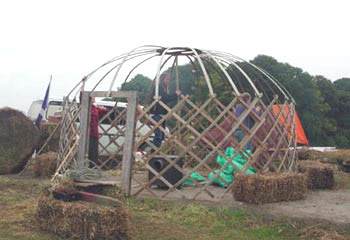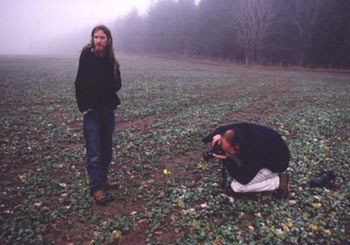Local inhabitants of the Scottish Highlands witnessed another GM crop fail in front of their very eyes. Scientists who have approved the UK farm-scale field trials should be held to account. Dr. Mae-Wan Ho reports.

The Munlochy Camp, November 2001
The temperature has dipped below zero for short spells since the beginning of November when the first snow arrived. It snowed again days before Christmas and also turned very cold. The children were taking advantage of a sunny break to decorate a Christmas tree by the freezing pond, their laughter bright and sparkling as fresh ice.
The Munlochy GM Vigil (munlochyvigil@tiscali.co.uk) had started up spontaneously in August after a local march and rally in protest of the GM crop trials approved by the Scottish Executive. That was despite repeated veto by the local inhabitants and their elected representative, the Highlands Council (see "Beware corporate takeover of organics" ISIS News 11/12).
Some local people went to see Jamie Grants Roskill Farm near Munlochy on Black Isle, where Aventis’ GM oilseed rape was to be planted. While they were there, a tractor appeared without warning, and started sowing the seeds, at which point, a dozen of the locals walked on to the field and sat down in front of the tractor, putting a stop to the sowing. The next day, many more people gathered at the field, and again, some put themselves in the tractor’s path. This time, eleven were arrested, ten of whom have been charged with aggravated trespass and are awaiting trial.

Constructing the Munlochy Yurt
Since then, a constant vigil had been kept near the field. An encampment has grown up at the site. The decisive act must have been the "raising of the yurt" towards the end of September, and which now forms the central feature of the camp. The original yurt, as explained to me, is a round Tibetan house with a wooden frame, covered with fur. The Munlochy version consists of a hemispheric plywood frame set on top of a cylindrical trellised wall, one and one-half metres tall, enclosing a space about four metres in diameter. The whole is draped with bright blue-green canvas. An opening at the top lets through the chimney connected below to a stove for cooking and to provide heating against the cold nights.
From the camp, a campaign has grown up to "stop the crop". More than 3000 signatures have been collected. Jamie Grant has tried to get them off the site, but the Highlands Council decided they had a right to be there in peaceful protest.
Chain-saw operator Anthony Jackson, thirty-ish with long-blond hair worn loose, and Nigel Mullan, 46, visual artist and sculptor, are two of the main ‘vigilantes’.

Anthony Jackson with a Press Association photographer. Notice the solitary flowering plant
"There’s a minimum of two or three of us constantly at the vigil. Then there are 30 to 40 regulars, the same number of supporters, and hundreds of friends and donors." Anthony said.
Across the road from the camp is the closely watched GM oilseed rape field trial. And nothing has escaped notice.
At the beginning of October, the field was sprayed with the herbicide glufosinate ammonium, as the GM oilseed rape is engineered to be tolerant to the herbicide, and it has also been treated with a fungicide. "It has rained quite heavily since the sprays and the runoff is directly into the Munlochy Bay. But the scientists have avoided sampling the water in the Bay." Nigel said. There is plenty of evidence that glufosinate is poisonous to a wide range of wild-life, and causes birth defects, which is why the herbicide is not approved for commercial use.

...the GM crop was severely stunted (GM to the left, control to the right.)
But it soon became clear that all was not well with the GM crop either. It was severely stunted compared with the control and commercial crops planted side by side. The GM crop was a quarter to a fifth the height of the control and commercial crops, and was noticeably more sparse and had more weeds growing in it.
"The control crop has substantial leafage and a closed canopy, thus restricting the amount of light available for weeds to grow," explained Anthony and Nigel. There was much more variation among the plants in the GM crop. Many of the leaves had turned yellow or had yellow edges. And one of the plants in the GM field had started to flower, "probably four months early".
In other words, the crop was showing typical signs of genetic instability that has plagued many other GM crops (see "Scrambled genome of RR soya" and other articles, ISIS News 9/10). This alone would invalidate any findings from the field trials, making the entire exercise pointless, particularly in the light of the new European Directive governing deliberate release of GM crops (see below).
The GM oilseed rape fiasco was reported in the local Highland News at the beginning of December. Aventis’ response was that although the varieties used are "very similar", the GM crop was of a "different" variety from the control, a fine example of Orwellian ‘doublespeak’.
And no wonder, this particular GM oilseed rape was approved as "substantially equivalent" (to non GM oilseed rape) by the Scientific Committee on Plants in Europe. But that was before the European Directive for deliberate release has been substantially strengthened last year (see "Europe's new rules could sink all GMOs" ISIS News 11/12 www.i-sis.org.uk). This change of reference makes the farm-scale field trials obsolete, because they are unlikely to pass muster for commercial approval at the end.
According to the report by the Agriculture and Environment Biotechnology Commission, the object of the farm-scale field trials is not to find out if the GM crops are safe. Yield is also not relevant measure, even though some farmer experiencing such a drastic crop failure might well commit suicide. Both those aspects have already been "approved by the regulatory authorities". The farm-scale field trials are not designed to answer all key questions about GM crops. Only "some key indicators of biodiversity" will be monitored to see if there are differences between the two halves of each field.
"This obviously makes a complete mockery of the science involved." Anthony and Nigel rightly conclude. The scientists who have approved such crops should be held to proper account.
Article first published 06/01/02
Comments are now closed for this article